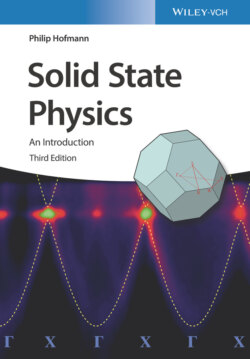Читать книгу Solid State Physics - Philip Hofmann - Страница 9
Preface to the First Edition
ОглавлениеThis book emerged from a course on solid state physics for third‐year students of physics and nanoscience, but it should also be useful for students of related fields such as chemistry and engineering. The aim is to provide a bachelor‐level survey over the whole field without going into too much detail. With this in mind, a lot of emphasis is put on a didactic presentation and little on stringent mathematical derivations or completeness. For a more in‐depth treatment, the reader is referred to the many excellent advanced solid state physics books. A few are listed in the Appendix.
To follow this text, a basic university‐level physics course is required as well as some working knowledge of chemistry, quantum mechanics, and statistical physics. A course in classical electrodynamics is of advantage but not strictly necessary.
Some remarks on how to use this book: Every chapter is accompanied by a set of “discussion” questions and problems. The intention of the questions is to give the student a tool for testing his/her understanding of the subject. Some of the questions can only be answered with knowledge of later chapters. These are marked by an asterisk. Some of the problems are more of a challenge in that they are more difficult mathematically or conceptually or both. These problems are also marked by an asterisk. Not all the information necessary for solving the problems is given here. For standard data, for example, the density of gold or the atomic weight of copper, the reader is referred to the excellent resources available on the World Wide Web.
Finally, I would like to thank the people who have helped me with many discussions and suggestions. In particular, I would like to mention my colleagues Arne Nylandsted Larsen, Ivan Steensgaard, Maria Fuglsang Jensen, Justin Wells, and many others involved in teaching the course in Aarhus.
